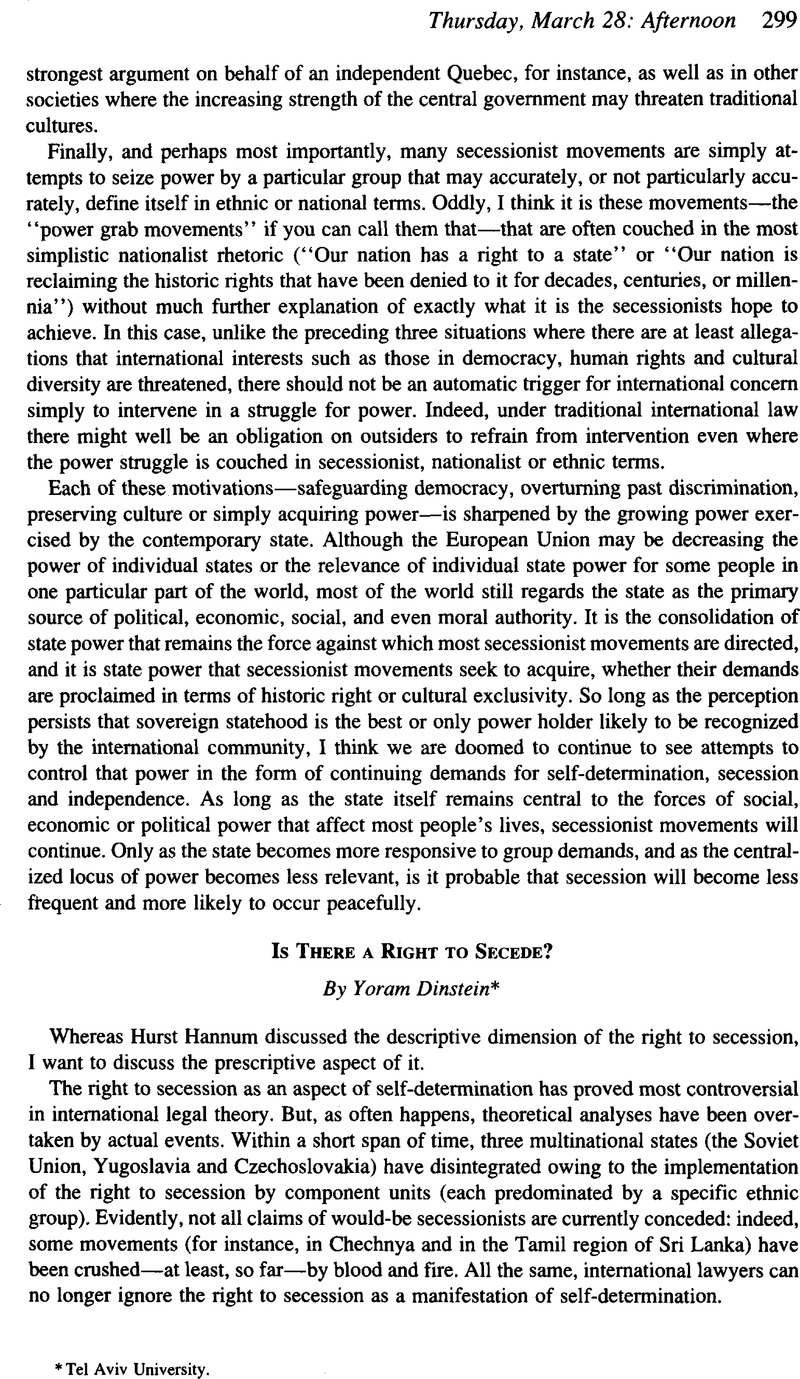No CrossRef data available.
Article contents
Is There a Right to Secede?
Published online by Cambridge University Press: 17 February 2017
Abstract

- Type
- International Responses to Secessionist Conflicts
- Information
- Copyright
- Copyright © American Society of International Law 2015
References
1 Tomuschat, C., Democratic Pluralism: The Right to Political Opposition, The Strength of Diversity 27 38 (Rosas, A. & Helgesen, J., eds., 1992)Google Scholar.
2 International Covenant on Civil and Political Rights, 999 UNTS 171 (1976); International Covenant on Economic, Social and Cultural Rights, 993 UNTS 3 (1976).
3 On the meaning of the term “peoples,“ see Dinstein, Y., Self-Determination Revisited, 1 Liber Amicorum Eduardo JimÉnez de ArÉchaoa 241, 241–244 (1994)Google Scholar.
4 See Blay, S.K.N., Self-Determination versus Territorial Integrity in Decolonization, 18 N.Y.U.J. Int'l L. & Pol. 331, 334–335 (1975–1976)Google Scholar.
5 See Franck, T.M. & Hoffman, P., The Right of Self-Determination in Very Small Places, 8 New York University Journal of International Law and Politics 441, 449–463 (1975–1976)Google Scholar.
6 Yale J. World Pub. Ord. See Clark, R.S., The Decolonization of East Timor and the United Nations Norms on Self-Determination and Aggression, 7 Yale J. World Pub. Ord. 2–44 (1980–1981)Google Scholar.
7 See Emerson, R., Self-Determination, 65 AJIL 459, 463–465 (1971)Google Scholar.
8 See Gilson, B., The Conceptual System of Sovereign Equality 455 (1984)Google Scholar.
9 GA Res. 2625 (XXV), 1970, 13 United Nations Resolutions (Series I: Resolutions Adopted by the General Assembly) 337 (J.J. Djonovich ed., 1976).
10 Ibid., 340.
11 Arangio-Ruiz, G., The UN Declaration on Friendly Relations and the System of the Sources of International Law 140 (1979)Google Scholar.
12 See Schoenberg, H.O., Limits of Self-Determination, 6 Israel Yearbook on Human Rights 91,95 (1976)Google Scholar.
13 Under Article 31(1) of the Vienna Convention on the Law of Treaties, the interpretation of a treaty is governed by the general rule that its terms be given the “ordinary meaning“ in their context. See United Nations Juridical Yearbook 140, 149 (1969). This is based on numerous dicta by the International Court of Justice. For instance: “The Court considers it necessary to say that the first duty of a tribunal which is called upon to interpret and apply the provisions of a treaty, is to endeavor to give effect to them in their natural and ordinary meaning in the context in which they occur. If the relevant words in their natural and ordinary meaning make sense in their context, that is an end of the matter.'’ Competence of the General Assembly for the Admission of a State to the United Nations, [1950] ICJ Rep. 4, 8.
14 Under Article 32 of the Vienna Convention, recourse may be had to the preparatory work of a treaty as a supplementary means of interpretation. Ibid., 149.
15 See UN Secretary General, Annotations on the Text of the Draft International Covenants on Human Rights 14 (Doc. A/2929, 1955). Compare Humphrey, J.P., Political and Related Rights, 1 Human Rights in International Law: Legal and Policy Issues 171, 196 (Meron, T. ed., 1984)Google Scholar.
16 Thornberry, P., International Law and the Rights of Minorities 214–215 (1991)Google Scholar.
17 See Hannum, H., Autonomy, Sovereignty, and Self-Determination 41–42 (1990)Google Scholar.
18 Such an approach is very common. See Friedlander, R.A., Self-Determination: A Legal-Political Inquiry, in Self-Determination: National, Regional, and Global Dimensions 307,313 (Alexander, Y. & Fried-lander, R.A. eds. (1980)Google Scholar.
19 Naturally, where there is a majority, there are also minorities. It may even happen that, subsequent to the formation of a new state in the name of self-determination of ethnic group A (for example, in the Baltic Republics), members of ethnic group B who formerly belonged to the majority group (Russians in the former USSR) are relegated to a minority position. See Y. Dinstein, The Degree of Self-Rule of Minorities in Unitarian and Federal States, Peoples and Minorities in International Law 221, 225–226 (C. Brölman et al. eds., 1993).
20 Franck, T.M., Postmodern Tribalism and the Right to Secession, Peoples and Minorities in International Law, id., 3, 16–19 Google Scholar.
21 Compare Brossard J., Le Droit du Peuple Québécois de Disposer de Lui-même au Regard du Droit International, 15 Canadian Yearbook of International Law 84, 115–116 (1977).
22 Supra note 2, at 180.
23 See Van Dyke, V., The Cultural Rights of Peoples, 2(2) Universal Human Rights 1, 5 (1980)Google Scholar.
24 As regards the reliance on self-determination in the case of Bangladesh, see Franck, T.M. & Rodley, N.S., The Law, the United Nations and Bangladesh, 2 Israel Yearbook on Human Rights 142, 159–163 (1972); Nanda, V.P., Self-determination in International Law, 66 AJIL 321, 328–336 (1972)Google Scholar.
25 Several states held that Biafra was entitled to political independence in light of the right of self-determination. See Ijalaye, D.A., Was “Biafra“ at Any Time a State in International Law? 65 AJIL 551, 554 (1971).Google Scholar




